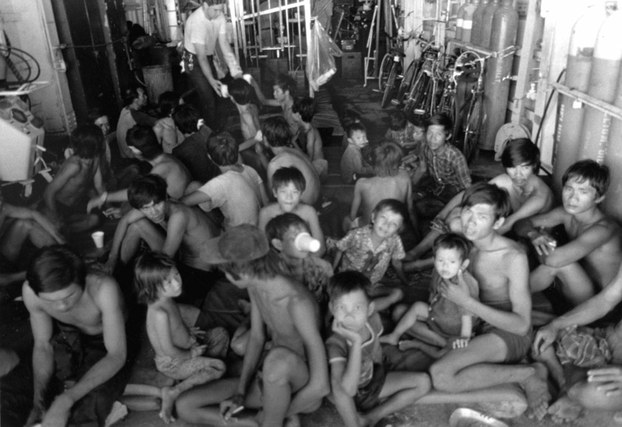Vietnam's boat people mark anniversary with return to refugee camps
| Publisher | Radio Free Asia |
| Publication Date | 4 September 2015 |
| Cite as | Radio Free Asia, Vietnam's boat people mark anniversary with return to refugee camps, 4 September 2015, available at: https://www.refworld.org/docid/561b978f12.html [accessed 19 May 2023] |
| Disclaimer | This is not a UNHCR publication. UNHCR is not responsible for, nor does it necessarily endorse, its content. Any views expressed are solely those of the author or publisher and do not necessarily reflect those of UNHCR, the United Nations or its Member States. |
2015-09-04
 Vietnamese boat people receive food and water after being rescued in a file photo. Photo courtesy of Wikipedia
Vietnamese boat people receive food and water after being rescued in a file photo. Photo courtesy of Wikipedia
A group of former "boat people" who fled persecution by the communist government in Hanoi at the end of the Vietnam War in 1975 recently toured resettlement camps in Southeast Asia to mark their journey to sanctuary 40 years earlier, and to honor those who were not so lucky.
The group set off from Australia on Aug. 20 as part of a "Back to Freedom" boat tour organized by the Archive of Vietnamese Boat People to sites in Malaysia, Indonesia, the Philippines and Thailand – four key destinations for refugees seeking asylum after the conflict.
During a stop on Malaysia's Bidong island, members of the group shared stories as a bus drove them to the former site of one of the largest refugee camps to house boat people in Southeast Asia before they were resettled to Western countries.
An island of less than one square mile (260 hectares) in area, Bidong was designated the principal refugee camp in Malaysia in August 1978 and prepped to receive some 4,500 asylum seekers, but by June the following year had a population of more than 40,000.
Conditions in the camp were cramped and unsanitary, while food and water had to be imported from the mainland by barge, and many refugees were forced to wait years on the island before being resettled.
But despite the grim state of the island camp, nearly 800,000 boat people fled Vietnam between the end of the war and the late 1990s to Malaysia and other regional countries, with as many as 400,000 perishing in the attempt, according to estimates by the United Nations High Commission for Refugees.
Since 2005, the Archive of Vietnamese Boat People has documented some 2,500 refugees known to have died during their flight from Vietnam.
Honoring the dead
Kha Van Long, a former boat refugee who joined the tour, told RFA's Vietnamese Service his impressions of the island 34 years after he left and was resettled in Australia.
"All of my memories of this place appear in my mind as if in a movie," he said.
"I visited cemeteries and felt sadness for those who were unable to reach the freedom they had dreamt of."
Truong Lam Bao Di, a former refugee who is now a doctor living in Canada, said many of the cemeteries the tour visited contained the remains of hundreds of boat people who had washed ashore after drowning when their vessels sank.
"We visited a grave in Malaysia where 46 people were buried, including one boy and two girls," he said.
"I suddenly became very emotional because it reminded me about my two little cousins who were with me [on our boat which sank]. I heard that when the boat foundered, my uncle put them on his shoulders, but they drowned together."
In addition to those who died in stormy seas, from starvation, and in pirate attacks, many boat people perished while awaiting resettlement. One cemetery on Bidong includes the remains of some who committed suicide after their bids for asylum were rejected.
The gravesites on Bidong have been restored by the Archive of Vietnamese Boat People through the contributions of ethnic Vietnamese around the world, and continue to be cared for by local residents.
During the tour visit to the island, the group held prayer ceremonies at four separate cemeteries under the supervision of Buddhist monks and nuns, and a Catholic priest.
Preserving history
While the group was pleased to see that the cemeteries had been maintained, much of the former Bidong refugee camp has since fallen into neglect, and the visitors said the site should be restored to ensure future generations understand the history of the boat people.
Kenneth Le, who was a refugee on Bidong as a teenager and is now a doctor living in the U.S., said sites like the island camp serve to show members of younger generations what sacrifices their relatives made to create a new life for their families.
"I saw some seniors bring children who were born in the U.S., Australia and Canada," he said of the tour group members.
"They are all teenagers, so they need to understand the reason behind their relatives' journey 40 years ago. Every time we visited a cemetery, we also went to the accompanying museum in order to thoroughly learn the history."
Tran Dong, director of the Archive of Vietnamese Boat People, said that his organization has plans to create a museum about the refugees to preserve their history for posterity.
Mass resettlement
Boat people fled Vietnam to arrive safely in countries including Malaysia, Indonesia, Thailand, the Philippines, Singapore and Hong Kong between 1975 and 1995.
More than one-half were resettled in the U.S., while most others were sent to France, Canada, Australia, Germany, and the U.K. Several tens of thousands were repatriated to Vietnam, either voluntarily or involuntarily.
The last refugee housed on Bidong left the island in 1991.
Reported by RFA's Vietnamese Service. Translated by KaLynh Ngo. Written in English by Joshua Lipes.
Link to original story on RFA website
